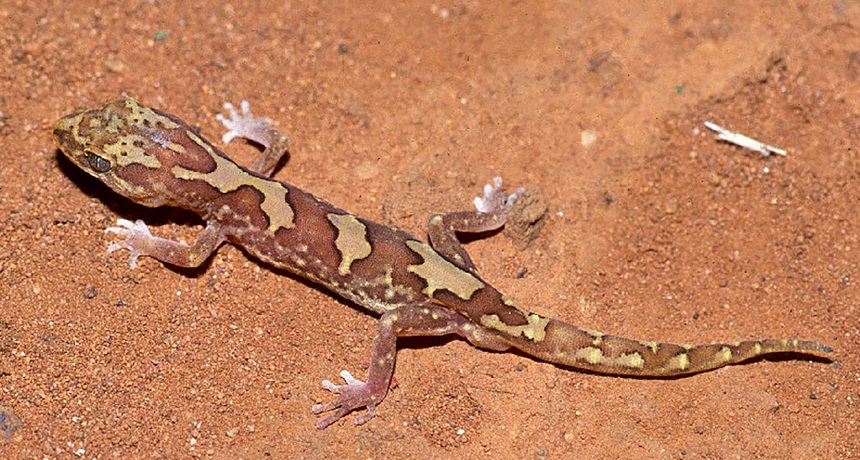Why you’ll never see a dirty gecko
Geckos have self-cleaning skin that helps the lizards stay dry and healthy

This box-patterned gecko stays healthy with help from its unique, self-cleaning skin.
State of Queensland (Dept. of Envmt. and Heritage Protection)
By Ilima Loomis
If you ever wear a self-cleaning jacket one day — and you may — it could have been inspired by a frozen lizard. A gecko, to be exact.
Australian scientist Jolanta Watson had removed the carcass of a box-patterned gecko from her lab’s freezer to prepare it for an experiment. As she looked at it, she noticed tiny water droplets forming all over the gecko’s skin. Quickly, the droplets got bigger. Then they started popping right off.
Watson and her husband, Gregory Watson, work at Australia’s University of the Sunshine Coast in Maroochydore, Queensland. As multidisciplinary scientists, they work in many fields. Over the years they have studied the unusual properties of insect and plant surfaces.
The scientists hadn’t set out to study the water-repelling behavior of gecko skin. They just followed where their research took them. And it quickly led to other gecko-skin surprises. For instance, when the Watsons looked closer, they realized the gecko had a self-cleaning skin.
The animals’ skin is covered with tiny, dome-shaped scales. Microscopic hairs atop each scale trap water from dew or mist. Those droplets bead together and eventually roll around the scales. Along the way, the droplets pick up dirt and dust. When the droplets get big enough, the spines fling off the now-dirty water.
BOUNCING DROPSThis video shows how small liquid droplets cannot sit on the lizard’s skin. Any that rain down upon it bounce up, again — and away James Cook University |
(Engineers recently created nano-scale spikes on the surface of a new plastic. Those bumps repel moisture and dirt in much the same way as the gecko skin did. This novel plastic made a new computer keyboard similarly self-cleaning.)
Many of the surfaces that the Watsons study are hydrophobic (HY-droh-FOH-bik) — meaning they resist water and don’t get wet. And quite a few geckos have skin that causes liquids to bead and roll off. But the box-patterned geckos appear to be among the more extreme. In fact, this lizard’s skin is so water repellent that the researchers now refer to it as super-hydrophobic.
And that shedding of liquid doesn’t stop with water. In lab tests, the skin also made other, very different liquids bead up the same way. These included coffee, soy sauce, vinegar, red wine, milk, cola and blood. What’s more, tiny beads of liquid don’t just roll off, the researchers found. Video and photographs showed the liquids often “jumping” off of the skin (see video).
But that’s not the only thing that helps keep these lizards clean and healthy. Their skin also has ultra-low adhesion, the researchers found. That means it is very hard for dust and other things to stick to it. The skin’s bumpy surface is amazingly uneven. This minimizes the number of points to which a speck of dirt can cling. Most “dirt” particles studied, such as pollen or dust, just rested on the humped top of the skin’s nanobumps. There they found it hard to get a firm grip.
Finally, the gecko skin could kill bacteria that touched it. But the skin caused no harm to human cells placed on it. The researchers are still trying to understand why it selectively killed the germs. They think that the structure of the skin, not any toxic chemicals in it, must be responsible.
Not just good for geckos
The new findings could lead to benefits for people. Watson’s team is now working with materials that mimic the gecko skin to study its properties. The science of inventing new technologies based on materials in nature is called biomimicry. Copying the non-wetting, dirt-resistant, antibacterial properties might lead to safer surfaces in hospitals. Or engineers might develop materials that protect the electronics on boats. And who wouldn’t want self-cleaning clothes?
Until now, most gecko studies have looked at the lizards’ feet. Their clinging toes have inspired scientists to develop new kinds of tape and other sticky materials. But since they had studied insect surfaces in the past, the Watsons and their colleagues were able to bring in a new perspective, says Alyssa Stark. She studies geckos at the University of Akron in Ohio. By looking at geckos in a new way, the Watsons discovered something interesting about the animals’ skin, she says.
“We now have a pretty exciting inspiration,” she says, “a self-cleaning surface that can get rid of dirt just by sitting there.”
The study on geckos’ self-cleaning skin was published online by the journal Interface on March 11. A second paper by the same team on the other properties of gecko skin appeared online in Acta Biomaterialia on March 22.







